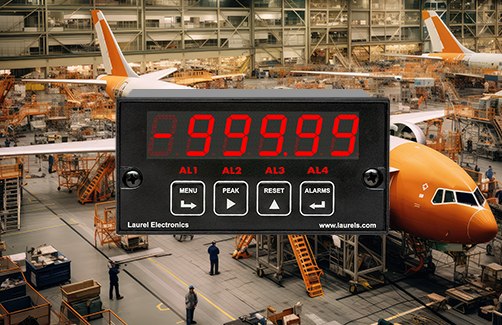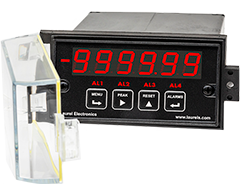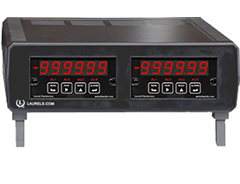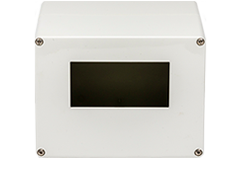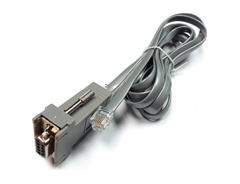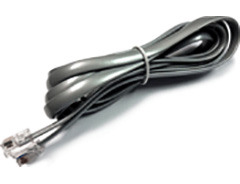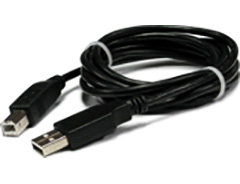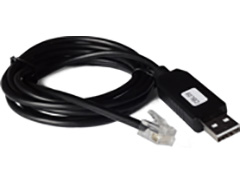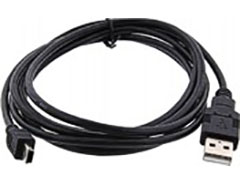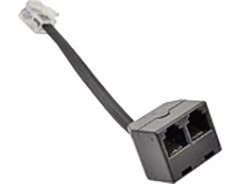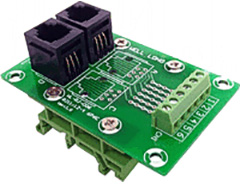- Description
- Specifications
- Setup Software
- Mechanical
- Documents
- Technical FAQ
- Applications
- Accessories
Features
- Reads process signals from ±200 mV to ±600V or ±2 mA to ±5A full scale
- Accuracy ±0.01% of reading ± 2 counts
- Absolute and ratiometric mode for bridges and potentiometers
- Error less than 0.01% of full scale for absolute ranges, less than 0.01% of reading for ratiometric measurements
- All input ranges are user selectable and factory calibrated
- Up to 60 conversions per second, Ideal for peak or valley capture
- Digital span adjust from 0 to ±99,999, zero adjust from -99,999 to +99,999
- Front panel scalable to ±99,999 for use with current shunts
- 1/8 DIN size with bright red or green 0.56" (14.2mm), high LED digits
- Transducer excitation output, 5, 10, 12, or 24 Vdc (isolated)
- Power 85-264 Vac / 90-300 Vdc or 10-48 Vdc / 12-32 Vac (isolated)
- Operating temperature from -40°C to 70°C (-40°F to 158°F)
- Wide choice of Plug-in-Play options:
- 2 or 4 relays, mechanical or solid state, for alarm or control (isolated)
- 1 or 2 Analog output, 4-20 mA, 0-20 mA, 0-10V, or -10V to +10V (isolated)
- Communications: Ethernet, WiFi, USB, RS232, RS485 (isolated)
- Extended DPM allows up to 180 data points for custom curve linearization
and a rate derived from consecutive readings
Laureate™ 1/8 DIN Digital Panel Meter for digital process
are a cost-effective solution for process signals such as 4-20 mA, 0-10V, or 0-5V. Full-scale voltage input ranges from ±200 mV to ±600V and current ranges from ±2 mA to ±5 A are jumper selectable. All ranges are precalibrated at the factory, so that recalibration is not needed when changing ranges or signal conditioners. The 200.00 mV and 2.000 V ranges provide a high input impedance of 1 Gohm to minimize the load on the voltage signal.The meter can be set to absolute and ratiometric (or potentiometer follower) mode by making a software selection. In this mode, the meter tracks a ratio of the applied excitation voltage and is unaffected by changes in the excitation voltage. Ratiometric measurements provide an exceptional accuracy of 0.01% of reading ± 2 counts. This capability is used with the meter's 5V or 10V excitation output for load cells and Wheatstone bridges, and with the meter's 5V excitation output for potentiometers which track wiper position.
All signal conditioner board ranges are factory-calibrated, with calibration factors for each range securely stored in an onboard EEPROM. These factors can be scaled via software to accommodate external shunts, enabling field replacement of signal conditioner boards without necessitating recalibration of the associated digital panel meter. For optimal accuracy, factory recalibration is recommended annually. All Laurel Electronics instruments undergo factory calibration using the industry-leading Fluke calibrators, which are recalibrated yearly and certified traceable to national standards, ensuring the highest level of precision and reliability.
The optional extended Laureate computer board enhances Laureate Digital Panel Meters by displaying rates derived from successive readings and enabling highly accurate custom curve linearization. For example, it can calculate liquid volume or flow rate in a horizontal cylindrical tank using levels from a 4-20 mA transmitter. Setup is straightforward: users input up to 180 data points into a spreadsheet or text file, and the computer calculates spline-fit segments, which are then downloaded to the meter for precise operation.
Laureate Digital Panel Meters are easily programmed with Laurel’s free Instrument Setup Software, downloadable from our website and compatible with Windows PCs, requiring a data interface board for setup.
Scaling is from -99,999 to +99,999 (five full digits) with any decimal point to display readings in engineering units, such as PSI. Three scaling methods are user selectable: scale and offset, two-point method, and system-level calibration using actual transducer signals.
High read rate of up to 50 or 60 conversions per second, the Laureate™ Digital Panel Meter uses Concurrent Slope (US Pat. 5,262,780) analog-to-digital conversion to integrate signals over a full power line cycle (50 Hz or 60 Hz). This read rate enables peak and valley capture, real-time computer interfacing, and control applications. Peak and valley values are automatically captured and can be viewed using Laurel’s free Instrument Setup Software (compatible with Windows PCs) or transmitted as serial data.
- An unfiltered selection provides true peak and valley readings and aids in control applications.
- A batch average filter selection averages each 16 conversions.
- An adaptive moving average filter selection provides a choice of 8 time constants from 80 ms to 9.6 seconds. When a significant change in signal level occurs, the filter adapts by briefly switching to the shortest time to follow the change, then reverts back to its selected time constant. An Auto setting selects the time constant selection based on signal noise.
Two tare functions: auto-tare and manual tare. In auto-tare, an input line is grounded by an external pushbutton. In manual tare, the tare value can be entered manually via a control input pushbutton or using Laurel's free Instrument Setup Software.
Peak and valley values are automatically captured. These may be displayed via a front panel pushbutton command or control signal at the rear connector, or be transmitted as serial data.
Two rear panel control Inputs (CMOS/TTL levels, logic 0 = tied to digital ground, logic 1 = open) or dry contacts that can be set to control / activate 14 meter commands.
An (isolated) 5, 10, 12, or 24 Vdc excitation output is standard to power transducers or two-wire transmitters. Ratiometric operation, which automatically compensates for changes in the applied excitation, is jumper selectable for applications, such as bridges, where the signal to be measured is proportional to the excitation level.
Modular Design for Maximum Flexibility at Minimum Cost
All boards are isolated from meter and power grounds. Optional Plug-in-Play boards for communications and control include Ethernet, WiFi, serial communication boards, dual or quad relay boards, and an analog output board. Laureates may be powered from 85-264 Vac or optionally from 12-32 Vac or 10-48 Vdc. The display is available with bright red or green 0.56" (14.2mm) high LED digits. The 1/8 DIN case meets NEMA 4X (IP65) specifications from the front when panel mounted. Any setup functions and front panel keys can be locked out for simplified usage and security. A built-in 5, 10, 12, or 24 Vdc excitation supply can power transducers, eliminating the need for an external power supply. All power and signal connections are via UL / VDE / CSA rated screw clamp plugs.
The Laureate™ Series features modular design with up to 7 isolated plug-in boards, applicable to all Laureate 1/8 DIN Digital Panel Meters.

Modular Hardware
The design of the Laureate™ Series is modular for maximum flexibility at minimum cost. All boards are isolated from meter and power grounds. The base configuration for a panel meter or counter consists of a main module (with computer and plug-in display boards), a power supply board, and a signal conditioner board. Optional plug-in-play boards include an isolated setpoint controller board, an isolated analog output board, and an isolated digital interface board. Modular design and a choice of plug-in options allow the Laureate to be customized for a broad range of applications from simple monitoring to control and computer interface. There can be up to five plug-in boards in a 1/8 DIN Laureate.

Connecting Laureate Digital Panel Meters to a Local Area Network (LAN)
Up to 30 Laureate Digital Panel Meters and/or LT Transmitters can be configured for RS485 and daisy-chained to an LT Transmitter using Laurel’s High Speed Ethernet-to-RS485 converter board for seamless LAN integration. Alternatively, Laurel LTE series Ethernet transmitters can connect directly to a LAN via an Ethernet cable. Setup for both configurations is streamlined using Laurel’s free Instrument Setup Software, which simplifies node discovery and transmitter configuration.
Flexible Communication Options for Digital Panel Meters
Laureate Digital Panel Meters can be equipped with Laurel communication boards to support various interfaces and protocols. These include serial interfaces with ASCII or Modbus RTU protocols, and Ethernet interfaces with web access, ASCII, or Modbus TCP/IP protocols, ensuring versatile connectivity for your commercial applications.

DC Voltage
| DC Voltage Range | Resolution | Input Resistance | Error at 25°C |
|---|---|---|---|
| ±200.00 | 10 µV | 1 GΩ | 0.01% of FS ± 2 cts |
| ±2.0000 | 100 µV | 1 GΩ | 0.01% of FS ± 2 cts |
| ±20.000 | 1 mV | 10 MΩ | 0.01% of FS ± 2 cts |
| ±200.00 | 10 mV | 10 MΩ | 0.01% of FS ± 2 cts |
| ±300.00 | 0.1 V | 10 MΩ | 0.01% of FS ± 2 cts |
| ±600.00* | 0.1 V | 10 MΩ | ± 0.4 V |
| * ±600.00V range not ETL certified. | |||
| Recalibration: All ranges are calibrated at the factory. Recalibration is recommended every 12 months. | |||
DC Current
| DC Current Range | Resolution | Input Resistance | Error at 25°C |
|---|---|---|---|
| ±2.0000 mA | 0.1 µA | 100 Ω | 0.01% FS ± 2 cts |
| ±20.000 mA | 1.0 µA | 10 Ω | 0.01% FS ± 2 cts |
| ±200.00 mA | 10 µA | 1 Ω | 0.01% FS ± 2 cts |
| ±5.000 A | 1 mA | 0.01Ω | ± 10 mA |
DC Voltage & Current
| Display | |
|---|---|
| Readout | 5 LED digits, 7-segment, 14.2 mm (.56"), red or green. |
| Range | -99999 to 99999 or -99990 to 99990 (count by 10) |
| Indicators | Minus sign, 2 red LED lamps |
| A-to-D Conversion | |
| Technique | Concurrent Slope™ (Pat 5,262,780) |
| A-to-D rate | 60/s at 60 Hz, 50/s at 50 Hz |
| Output update rate | 56/s at 60 Hz, 47/s at 50 Hz |
| Display update rate | 3.5/s at 60 Hz, 3/s at 50 Hz |
| Reading Accuracy | |
| Error at 25°C | 0.01% of full scale ± 2 counts (except 5A range) for absolute measurements. 0.01% of reading ± 2 counts for ratiometric measurements. |
| Span tempco | 0.003% of reading/°C |
| Zero tempco | 0.1 count/°C |
| Noise Rejection | |
| CMR, DC to 60 Hz | 130 dB |
| NMR at 50/60 Hz | 90 dB with min filtering |
| Maximum Signal | |
| Max applied voltage | 600 Vac for 20, 200 and 300 V ranges, 125 Vac for other ranges |
| Overcurrent protection |
25x for 2 mA, 8x for 20 mA, 2.5x for 200 mA, 1x for 5 A |
| Power | |
| Voltage, standard | 85-264 Vac or 90-300 Vdc |
| Voltage, optional | 12-32 Vac or 10-48 Vdc |
| Frequency | DC or 47-63 Hz |
| Power consumption (typical, base meter) | 1.2W @ 120 Vac, 1.5W @ 240 Vac, 1.3W @ 10 Vdc, 1.4W @ 20 Vdc, 1.55W @ 30 Vdc, 1.8W @ 40 Vdc, 2.15W @ 48 Vdc |
| Power Isolation | 250V rms working, 2.3 kV rms per 1 min test |
| Excitation Output (standard) | |
| 5 Vdc | 5 Vdc ± 5%, 100 mA (jumper selectable) |
| 10 Vdc | 10 Vdc ± 5%, 120 mA (jumper selectable) |
| 12 Vdc | 12 Vdc ± 5%, 100 mA (jumper selectable) |
| 24 Vdc | 24 Vdc ± 5%, 50 mA (jumper selectable) |
| Output Isolation | 50 Vdc from signal ground |
| Ratiometric operation | 5 Vdc or 10 Vdc for bridge circuits, 5 Vdc for potentiometers |
| Analog Output Board (optional) | |
| Output levels | 4-20 mA, 0-20 mA, 0-10V, -10 to +10V (jumper selectable) |
| Current compliance | 2 mA at 10V ( > 5 kΩ load) |
| Voltage compliance | 12V at 20 mA (< 600 Ω load) |
| Scaling | Zero and full scale adjustable from -99999 to +99999 |
| Resolution | 16 bits (0.0015% of full scale) |
| Step function response | 80 ms to 99% of final value (typ) |
| Isolation | 250V rms working, 2.3 kV rms per 1 min test |
| Relay Output Boards (optional) | |
| Relay types | 2 Form C contact relays or 4 Form A contact relays (NO) 2 or 4 Form A, AC/DC solid state relays (NO) |
| Current tatings | 8A at 250 Vac or 24 Vdc for contact relays 120 mA at 140 Vac or 180 Vdc for solid state relays |
| Output common | Isolated commons for dual relays or each pair of quad relays |
| Isolation | 250V rms working, 2.3 kV rms per 1 min tes |
| Communication Boards (optional) | |
| Board Selections | RS232, RS485 with dual RJ11 connectors, RS485 with dual RJ45 connectors, USB, High-Speed Ethernet, USB-to-RS485 gateway, High-Speed Ethernet-to-RS485 gateway, WiFi with built-in antenna plus USB & RS485, WiFi with external antenna plus USB & RS485 |
| Protocols | Laurel Custom ASCII (serial), Modbus RTU (serial), Modbus TCP (Ethernet or WiFi) |
| Digital addresses | 247 (Modbus), 31 (Laurel ASCII), |
| Isolation | 250V rms working, 2.3 kV rms per 1 min test |
| Signal Connections | |
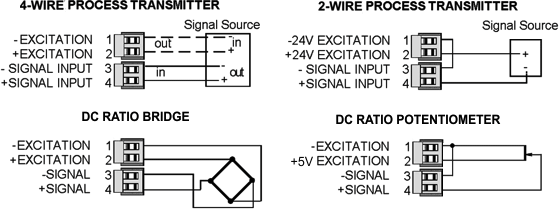 |
|
| Environmental | |
| Operating temperature | -40°C to 70°C (-40°F to 158°F) |
| Storage temperature. | -40°C to 85°C (-40°F to 185°F) |
| Relative humidity | 95% at 40°C, non-condensing |
| Protection | NEMA-4X (IP-65) when panel mounted |
| Mechanical | |
| Enclosure | 1/8 DIN, high impact plastic, UL 94V-0, color: black |
| Mounting | 1/8 DIN panel cutout required: 3.622" x 1.772" (92 mm x 45 mm). |
| Dimensions | 4.68" x 2.45" x 5.64" (119 mm x 62 mm x 143 mm) (W x H x D) |
| Maximum panel thickness | 4.5 mm (0.18") |
| Tightening Torque - Connectors | Screw terminal connectors: 5 lb-in (0.56 Nm) |
| Tightening Torque - Pawls | Digital Panel Meter Case Pawls: 5 lb-in (0.56 Nm) |
| Weight of base meter | 210 g (7.4 oz) typical (DPM, counter, timer, 6-digit remote display) |
| Weight of option boards | 30 g (1.0 oz) typical per board (analog output, relay output, communications) |
| General | |
| Programming Methods | Four front panel buttons or via Laurel's free Instrument Setup Software, which runs on a PC under MS Windows. |
| Security | Lockout options include using the front panel buttons, the free Instrument Setup Software, or a hardware jumper. |
| Warranty | 3 years parts & labor |
| Recalibration: All ranges are calibrated at the factory. Recalibration is recommended every 12 months. | |
Free Instrument Setup Software for Series 2 Laureates
Free Downloadable Windows-based Instrument Setup (IS) software (Data Interface Board Required) for use with our programmable Digital Panel Meters, Scale Meters, Counters, Timers, Remote Displays, and Transmitters, are an easy method to set up Laureate 1/8 DIN digital panel meters, counters, timers, remote displays, and DIN-rail transmitters, as explained in the Instrument Setup Software Manual. Laureate 1/8 DIN instruments can also be set up from the front panel, as explained in their respective Owners Manuals. Instrument Setup software is of benefit whether or not the PC is connected to the instrument.
- When the PC is connected to the instrument, Instrument Setup software can retrieve the setup file from the instrument or open a default setup file or previously saved setup file from disk View Setup, then provides graphical user interface (GUI) screens with pull-down menus applicable to input, display, scaling, filtering, alarms, communications, analog output, and front panel lockouts. Fields that are not applicable to the instrument as configured are either left out or grayed out. Clicking on any item will bring up a detailed Help screen for that item. After editing, the setup file can be downloaded, uploaded to the instrument, or saved to a disk. The same setup file can then be downloaded into multiple instruments.
- When the PC is not connected to the instrument, the above GUI screens can be used to set up a virtual instrument. The setup file can then be saved to disk. Switching toView Menu then brings up a screen with the required front panel programming steps. This view can be printed out for use at the instrument site and to serve as a hard copy record.
Download Free Instrument Setup Software
Installation
Set User Account Control (UAC) of MS Windows to "Never notifiy me" so that Instrument Setup Software can create directories. The UAC change screen can be reached as follows:
- Under Windows 7, click on the Windows Start button in the lower left of the desktop and enter "UAC" in the search field.
- Under Windows 8, navigate to Control Panel, then to the "User Accounts and Family Safety" section, and click on "Change User Account Control Settings."
- Under Windows 10, click on the Windows Start button in the lower left of the desktop, then on "Settings", and enter "UAC" in the search field.
- Reboot your computer for the changed UAC setting to take effect.

RJ11-to-DB9 cable with rear view of DB9 connector to PC

RS232 cable, meter to PC, P/N CBL01
Laureate 1/8 DIN Laureate instruments must be equipped with a serial communications board and be connected to the computer via a serial communications cable. The connection can be via RS232, RS485, USB or Ethernet. Following setup, the serial communications board may be removed from the instrument if desired. The wiring of the RS232 cable is illustrated above with end views of the two connectors.
Laureate LT Series transmitters come standard with a 3-wire serial interface, which can be jumpered for RS232 or RS485.
Laureate LTE Series transmitters come standard with an Ethernet interface.
Meter Setup Screens
Click on any of the reduced screens below for a full-size screen view, then click on the Back button of your browser to return to this page. The screens examples below are for a fully-loaded Series 2 Digital Panel Meter (DPM), which is connected to the PC via RS232. If the meter is a Series 1 meter (pre-2007), this is sensed by the software, and somewhat different screens are brought up. Please see Series 1 setup screens.











Meter Setup Utilities




From the Main Menu, click on Readings if your PC is connected to the meter. A pull-down menu then offers three choices: List, Plot and Graph.
- List presents the latest readings in a 20-row by 10-column table. Press Pause at any time to freeze the display. This is one method to capture peak readings.
- Plot generates a plot of readings vs. time in seconds. It effectively turns the DPM-PC combination into a printing digital oscilloscope.

- Graph generates a histogram where the horizontal axis is the reading and the vertical axis is the number of occurrences of readings. The display continually resizes itself as the number of readings increases.



Laureate™ 1/8 DIN Case For Laureate Digital Panel Meters, Counters, Timers & Remote Displays
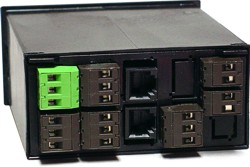
Key Features
- Meets 1/8 DIN Standard.
- Installs from front of panel.
- Short depth behind the panel: only 4" (102 mm) plus connectors.
- Understated 0.157" (4 mm) thick bezel.
- Meets NEMA 4X (IP-65) for high-pressure wawshdon when panel mounted.
- Screw clamps connectors meet VDE / IEC / UL / CSA safety standards.
- Rugged GE Lexan® housing material.
- Safety certified per EN 61010-1.
Dimensions
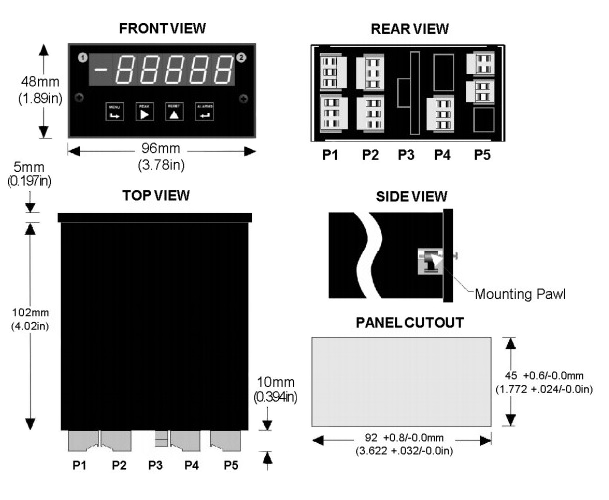
Maximum panel thickness: 4.5 mm (0.18")
Weight of base meter: 210 g (7.4 oz) typical (DPM, counter, timer, 6-digit remote display)
Weight of option boards: 30 g (1.0 oz) typical per board (analog output, relay output, communications)
Tightening Torque - Connectors: Screw terminal connectors: 5 lb-in (0.56 Nm)
Tightening Torque - Pawls: Digital Panel Meter Case Pawls: 5 lb-in (0.56 Nm)
Dimensioned CAD assembly drawings in EPRT, STEP, x_t. dwg, pdf file formats: Laureate-meter-case.zip (zipping prevents browser from opening CAD files as text files).
Panel Mounting
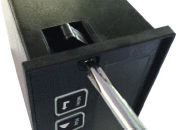 Slide the meter into a 45 x 92 mm 1/8 DIN panel cutout. Ensure that the provided gasket is in place between the front of the panel and the back of the meter bezel.
The meter is secured by two pawls, each held by a screw, as illustrated. Turning each screw counterclockwise extends the pawl outward from the case and behind the panel. Turning each screw clockwise further tightens it against the panel to secure the meter.
Slide the meter into a 45 x 92 mm 1/8 DIN panel cutout. Ensure that the provided gasket is in place between the front of the panel and the back of the meter bezel.
The meter is secured by two pawls, each held by a screw, as illustrated. Turning each screw counterclockwise extends the pawl outward from the case and behind the panel. Turning each screw clockwise further tightens it against the panel to secure the meter.
Turning each screw counterclockwise loosens the pawl and retracts it into its well. This position allows installed meter to be removed from their panel, or new meters to be installed in a panel. Do not remove the screws from their pawls. Doing so would cause the screw and pawl to fall off and likely get lost. Do not overtighten so as not to damage the plastic parts.
Process Signal and Ratiometric Meter Frequently Asked Technical Questions
Ratiometric potentiometer follower application
In this application shown, the signal from a sliding contact voltage divider can be converted to engineering units such as position, level or percentage. By operating in a ratiometric mode, the meter automatically removes any effects caused by variations in the excitation supply. Connect excitation return to signal return, and jumper the excitation output to 5 Vdc.
  |
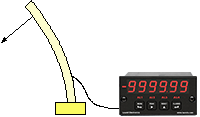 |
Powering two-wire transmittersThe isolated 24 Vdc, 50 mA excitation output, which is standard with all Laureate meters, is ideal for powering two-wire, 4-20 mA transmitters. The same two wires are used to apply voltage and carry the output current. Inside the meter, the 4-20 mA current is dropped across a 10 ohm resistor and sets up a 40-200 mV voltage, which is then sensed by the meter and scaled to engineering units.
|
Testing with peak detectionDestructive testing is an ideal application for the Laureate strain meter. Peak readings are automatically captured at rates up to 60 per second, while the display updates at a legible 3.5 readings per second. The peak reading can be recalled at the push of a button or be transmitted via RS-232 or RS-485. The meter provides isolated 10 Vdc power for up to four (4) the strain gauges and can be scaled to read out directly in engineering units from -99,999 to +99,999.
|
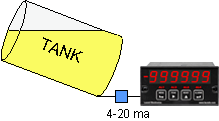 |
 |
Custom curve linearizationThe Laureate DC meter with the Extended main board option allows exceptionally accurate custom curve linearization. For setup, up to 180 data points can be entered into a spreadsheet. The system then creates multiple non-linear spline-fit segments, which provide much better accuracy than linear segments. Illustrated, is the readout of volume of irregularly shaped tanks based on measured liquid level or pressure. Altimeters and thermistors are further applications.
|
Rate from successive readingsThe Extended computer board allows the display of rate based on successive readings, for instance flow rate based on changes in liquid level or static pressure in a tank. In the above illustration, the meter displays the rate in gallons at which a horizontal tank is being emptied. The input to the meter can be nonlinear, since only the linearized readings are compared for the determination of rate.
|
IPC
Splashproof Cover
CLB01
RS232 Cable for Meters
CLB02
USB-to-RS232 Adapter Cable
CBL04
RS232 Cable for LT Transmitters
CLB05
USB Data Cable for Meters
CLB06
USB-to-RS485 Adapter Cable
CLB07
USB Programming & Data Cable
CLB08
RS485 Splitter Cable
BKBD
RS485 RJ11 Terminal Block Adapter
What is a Digital Panel Meter for Process and Ratiometric Applications?
A digital panel meter is a precision instrument designed to measure, display, and monitor electrical signals for process and ratiometric applications. These meters are critical in industrial settings where accurate monitoring of process variables, such as voltage, current, or resistance, and ratiometric measurements, such as those from bridge-based sensors like strain gauges or potentiometers, is essential. Used in automation, manufacturing, and control systems, digital panel meters ensure reliable data for process optimization, quality control, and system efficiency.
Unlike traditional analog meters, digital panel meters provide enhanced readability, programmable features, and seamless integration with modern control systems. Their ability to handle process signals and ratiometric inputs makes them indispensable for applications requiring precise and stable measurements in dynamic environments.
Understanding the Digital Panel Meter for Process and Ratiometric Measurements
Digital panel meters for process and ratiometric applications are typically built to the 1/8 DIN standard, fitting compactly into panel cutouts (approximately 92 mm x 45 mm). This compact size ensures compatibility with control panels while maximizing space efficiency, making them ideal for industrial control rooms, automation systems, or equipment with limited space.
These meters are designed to process a wide range of input signals, including 4-20 mA, 0-10 V, or ratiometric outputs from bridge circuits (e.g., Wheatstone bridges used in strain gauges or load cells). They feature customizable displays, advanced calibration options, and communication interfaces like RS-485 or Modbus, enabling integration with PLCs, SCADA systems, or data acquisition networks. Their robust design ensures reliable performance in harsh industrial conditions.
How Does a Digital Panel Meter Work in Process and Ratiometric Applications?
A digital panel meter processes analog signals from process sensors or ratiometric devices to deliver accurate digital outputs. Below is a detailed breakdown of its operation:
- Signal Acquisition:
The meter receives an analog signal from a sensor, such as a 4-20 mA current loop from a pressure transmitter or a ratiometric voltage from a strain gauge bridge. These signals represent process variables or proportional measurements. - Signal Conditioning:
The input signal is conditioned through amplification, filtering, or normalization to ensure accuracy and stability. For ratiometric measurements, the meter compensates for variations in excitation voltage, ensuring consistent readings. - Analog-to-Digital Conversion:
An Analog-to-Digital Converter (ADC) transforms the conditioned signal into a digital format. High-resolution ADCs are essential for capturing small changes in process or ratiometric signals. - Processing and Display:
The digital signal is processed by the meter’s microcontroller, which applies scaling, linearization, or unit conversions (e.g., psi, %, or ohms). The result is displayed on a clear LED or LCD screen, often with customizable units or decimal precision. - Output and Integration:
The meter may provide outputs like analog signals (4-20 mA), relay contacts for alarms, or digital communication (e.g., Ethernet, USB) for integration with industrial control systems or data loggers. - Calibration and Configuration:
Users can calibrate the meter for specific sensors and configure settings like measurement ranges, alarm thresholds, or scaling factors to meet application requirements. Ratiometric applications often require precise calibration to account for bridge characteristics.
Key Features of Digital Panel Meters for Process and Ratiometric Applications
Digital panel meters for process and ratiometric measurements include features that enhance functionality and usability:
- High Accuracy: Precision ADCs and signal conditioning ensure reliable measurements, even for low-level ratiometric signals.
- Ratiometric Compensation: Built-in compensation for excitation voltage variations ensures stable readings from bridge-based sensors.
- Programmable Scaling: Users can linearize or scale inputs to match process variables or engineering units, improving flexibility.
- Customizable Displays: Multi-color LEDs, bar graphs, or large-digit displays ensure readability in industrial environments.
- Communication Interfaces: Support for Modbus, Profibus, or Ethernet enables integration with automation systems.
- Robust Construction: IP65-rated front panels resist dust and moisture, ideal for harsh industrial settings.
Applications of Digital Panel Meters in Process and Ratiometric Systems
Digital panel meters are widely used in process and ratiometric applications across industries. Key applications include:
- Process Monitoring:
In industrial automation, digital panel meters monitor process variables like pressure, flow, or temperature from 4-20 mA or 0-10 V sensors, ensuring consistent production quality. - Ratiometric Measurements:
Bridge-based sensors, such as strain gauges or potentiometers, produce ratiometric outputs. Digital panel meters process these signals for applications like tension control or position sensing. - Quality Control:
In manufacturing, DPMs monitor process signals to detect deviations, ensuring products meet specifications and reducing waste. - Environmental Control:
Digital panel meters track variables like humidity or gas concentration in HVAC or environmental systems, supporting regulatory compliance. - Test and Measurement Systems:
In laboratories, DPMs measure ratiometric signals from sensors during material testing or equipment calibration, providing accurate data for research.
Where Are Digital Panel Meters for Process and Ratiometric Applications Used?
Digital panel meters (DPMs) are essential in industries requiring precise process and ratiometric measurements. When paired with process sensors or bridge-based devices, 1/8 DIN digital panel meters offer compact, reliable solutions. Below are detailed use cases across key sectors:
- Industrial Automation and Manufacturing:
In automated production lines, digital panel meters monitor process signals from pressure transducers or flow meters. For example, in automotive manufacturing, DPMs track hydraulic pressure to ensure consistent assembly quality. - Chemical and Petrochemical Processing:
Digital panel meters measure variables like flow rates or tank levels using 4-20 mA sensors, ensuring safe and efficient operation in chemical plants or refineries. - Ratiometric Sensor Applications:
In packaging machines, strain gauges monitor web tension. Digital panel meters process ratiometric signals to maintain consistent material feed, preventing jams or defects. - HVAC and Building Management:
DPMs monitor environmental parameters like air pressure or temperature in HVAC systems, optimizing energy efficiency and occupant comfort. - Water and Wastewater Treatment:
Digital panel meters track process signals from flow or level sensors, ensuring accurate dosing of chemicals and compliance with environmental regulations. - Test and Calibration Laboratories:
In research facilities, DPMs measure ratiometric signals from potentiometers or strain gauges during equipment calibration or material stress testing, supporting precise data collection. - Energy and Utilities:
In power plants, digital panel meters monitor process variables like steam pressure or turbine load, helping operators maintain efficiency and prevent equipment failures.
Benefits of Using Digital Panel Meters in Process and Ratiometric Applications
Digital panel meters offer several advantages for process and ratiometric measurements:
- Precision and Stability: High-resolution ADCs and ratiometric compensation ensure accurate and consistent measurements.
- Compact Design: The 1/8 DIN size fits seamlessly into control panels, ideal for space-constrained environments.
- Versatility: Support for multiple input types and programmable settings accommodates diverse process and ratiometric applications.
- System Integration: Communication options enable connection to industrial networks, enhancing automation and data logging.
- Durability: Designed for industrial conditions, DPMs withstand vibration, temperature extremes, and moisture.
- Ease of Use: Intuitive interfaces and clear displays simplify configuration and operation, reducing setup time.
Choosing the Right Digital Panel Meter for Process and Ratiometric Applications
When selecting a digital panel meter for process and ratiometric measurements, consider these factors:
- Input Compatibility: Ensure the meter supports your sensor’s signal type (e.g., 4-20 mA, ratiometric bridge output) and range.
- Accuracy Requirements: Verify the meter’s resolution and accuracy for precise process or ratiometric measurements.
- Environmental Conditions: Choose a meter with appropriate IP ratings for dust, water, or temperature resistance in industrial settings.
- Output Needs: Determine if you require analog outputs, relays, or digital communication for system integration.
- Display and Controls: Opt for a display that’s readable in your environment and controls that are user-friendly.
- Calibration Features: Look for advanced calibration options, especially for ratiometric applications requiring bridge compensation.
Conclusion
Digital panel meters, particularly 1/8 DIN models, are vital for process and ratiometric applications in industries like manufacturing, chemical processing, and automation. Their precision, compact design, and advanced features make them ideal for monitoring process variables and ratiometric signals from sensors like strain gauges or potentiometers. By delivering accurate, real-time data and integrating seamlessly with control systems, digital panel meters enhance efficiency, ensure quality, and support reliable operations in demanding environments.
Less Information.








